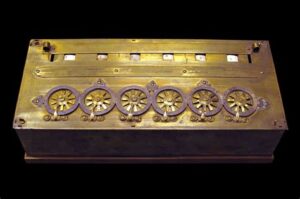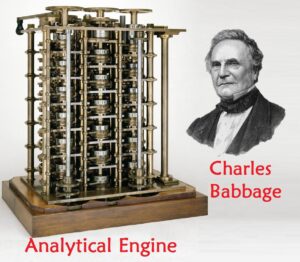Back to: Computer Studies JSS1
Welcome to class!
In today’s class, we shall be talking about the historical developments of computers, and we will be emphasizing on early computer devices. I trust you are going to enjoy the class. Let’s get started!
Historical Developments of Computers – Early computer devices
Computers are an essential part of our modern world. They are used in almost every aspect of our lives, from work and school to entertainment and communication. But how did computers come to be? Let’s take a look at the historical developments of computers, focusing on early computer devices.
The Abacus

The abacus is one of the earliest known computing devices. It is a manual counting device that originated in Mesopotamia around 2400 BC. The abacus is still used today, particularly in Asia. It consists of a frame with rods or wires on which beads are strung. The beads are moved to represent different numbers, and calculations are performed by moving the beads.
Pascaline

Pascaline was invented by Blaise Pascal in 1642. It was a mechanical calculator that could perform addition and subtraction. It worked by using gears and wheels to represent numbers. The Pascaline was the first mechanical calculator to be produced in any quantity and actually used.
Difference Engine

The Difference Engine was invented by Charles Babbage in 1822. It was a mechanical computer that could perform calculations for polynomial equations. It worked by using a system of cogs and wheels to represent numbers. The Difference Engine was never fully completed, but it was a major step forward in the development of computers.
Analytical Engine
The Analytical Engine was also invented by Charles Babbage in 1833. It was a general-purpose computer that could perform a wide range of calculations. It used punch cards to input data and instructions. The Analytical Engine is considered to be the first design for a computer in the modern sense.
In conclusion, the early computer devices were a major breakthrough in the history of computing. They laid the foundation for the development of modern computers. Today, computers are more powerful and versatile than ever before, and they continue to play an important role in our lives.
We have come to the end of today’s class. I hope you enjoyed the class!
In the next class, we shall be discussing Mechanical Counting and Calculating Devices.
In case you require further assistance or have any questions, feel free to ask in the comment section below, and trust us to respond as soon as possible. Cheers!
Question Time:
- When and where did the abacus originate?
- What were some of the limitations of the Pascaline?
- How did the Difference Engine work?
- What was the significance of the Analytical Engine?
- What are some of the challenges that early computer pioneers faced?
- How did early computer devices differ from modern computers?
- What are some of the ways that early computer devices have impacted our lives?
- What are some of the future implications of computers?
